
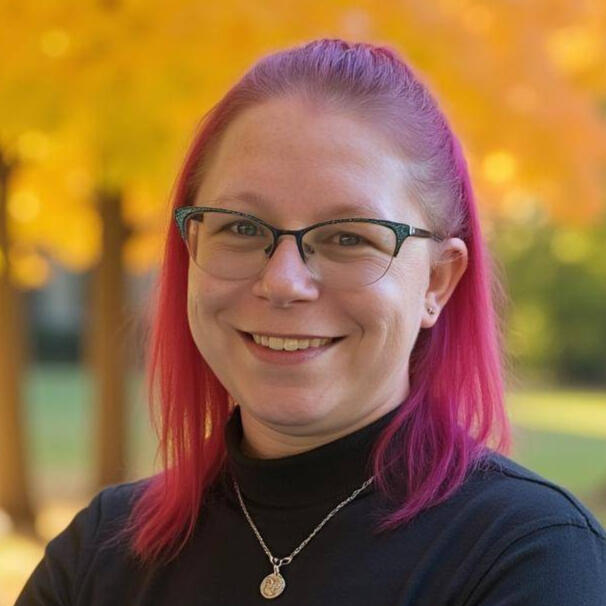
Hi! I'm Michelle (Hebert) Thomas, an award winning Sound Designer with 15 years of Game Industry Experience in AAA and AA games. I've worked in Account Administration, Quality Assurance, Sound Design, Implementation, and Project Management with a player experience first mindset. I'm interested in finding fun indie projects and collaborative teams to work with. Let's connect if you're looking for Game Audio resources.
What folks have said about working with me...
I was brought onto Rot in a Porcelain Dream through Unlock Audio to design voice-over effects for the game’s original constructed language and its cast of surreal, otherworldly characters. Yamo Studios spent years developing a unique fantasy dialect for ROT, and Unlock Audio was entrusted with transforming those fictional phonetics into emotionally resonant, fully voiced performances. Voice Direction, Casting, and Editing were led by Bonnie Bogovich, with performances by Nazeeh Tarsha, Paul Warren, Maia Harlap, and an ensemble cast. My role focused on sculpting the raw vocal recordings into the dreamlike, decaying aesthetic of the game world—enhancing clarity, emotional depth, and immersion without breaking the illusion of language.DAW: Reaper
Plugins: Zynaptiq Adaptiverb, Antares Throat, Convolution Reverbs, EQ & Pitch Modulation Tools
The Burdened
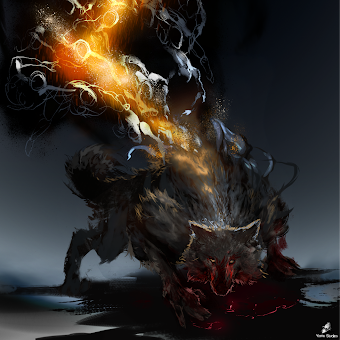
Concept:
The Burdened is an ancient creature tormented by the weight of countless devoured souls. A being whose voice carries grief, wisdom, and the constant threat of fragmentation. My goal was to design a vocal identity that reflects this layered inner world: resonant, spectral, and heavy with sorrow, yet still grounded enough for players to understand the emotional truth beneath its monstrous form.
Gameplay Footage - Yamo Studios
Voice FX Design by Michelle Hebert
Design Approach
Working from a clean vocal performance, I built a processing chain that subtly fractures the voice without losing intelligibility. Each effect was chosen to suggest the presence of many souls speaking through a single vessel, an entity forever caught between hunger, regret, and reluctant wisdom.
Before & After
Red

Concept:
Red is a stoic, world-weary warrior who has fought for an unthinkably long time against corrupted foes, some of them people he once loved. His voice must reflect the exhaustion of endless battle, the restraint of a man who speaks little, and the controlled intensity that surfaces when he engages with enemies or memories of his past. The vocal design aims to capture his emotional heaviness, internal conflict, and the muted resonance of a fighter who carries grief as readily as his weapon, all while grounding him within the surreal, decaying environments of the Dream.
Design Approach
As the helmeted main character, Red required a vocal treatment that preserved clarity while still sounding enclosed and physically grounded within his armor. I began by pitching his voice down slightly to add depth and weary warmth, reinforcing his age, fatigue, and emotional weight.To achieve the sense of speaking from within a confined space, I used convolution reverb modeled on helmet acoustics capturing the resonant reflections and softened upper harmonics characteristic of a metal or hardened enclosure. Because the game’s world is literally rotting away, every character in ROT carries a subtle layer of environmental decay; for Red, I incorporated a Cave IR and Zynaptiq Adaptiverb to create spectral, dreamlike tails that help situate him within the universe’s collapsing atmosphere.
Before & After
Ela
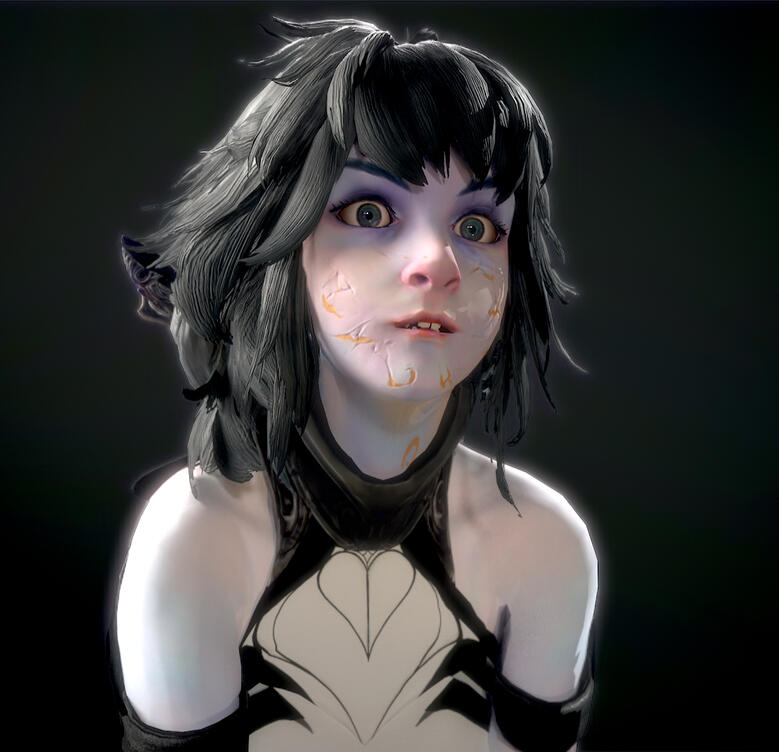
Concept:
Ela is an energetic, absent-minded fragment. Playful, curious, and happy-go-lucky, yet capable of sudden, frightening bursts of destructive power. She speaks in short, broken phrases, often relying on expressive sounds rather than language. Beneath her innocence is an unstable well of magical energy that can overwhelm her without warning. Her voice needed to capture this contrast: childlike and bright, but edged with unpredictability, always hinting at the dangerous power simmering underneath.
Gameplay Footage - Yamo Studios
Voice FX Design by Michelle Hebert
Design Approach
To shape her youthful, impulsive sound, I used Antares Throat Modeling to subtly shift her timbre toward a lighter, more childlike resonance while preserving her emotional expressiveness. Because Ela communicates as much through nonverbal sounds as through speech, the design emphasized clarity and personality over heavy processing. I added a medium, dry echo to give her voice a delicate, ethereal shimmer, something that feels magical without distancing her from the listener. As with all characters in ROT, I applied Cave IR reverb and harmonic filtering to anchor her within the rotting Dream environment. The final result balances innocence and instability: a voice that can feel sweet and airy one moment, then erupt with startling intensity the next, reflecting both her fragility and her immense, volatile power.
Before & After
Red, The Burdened, and Ela are just a few highlights from the full range of character voices designed for Rot in a Porcelain Dream.For an inside look at how Unlock Audio approached the game’s constructed language and vocal identity, you can explore the studio feature Giving Voice to Fantasy Game Languages
I was brought onto Autopsy Simulator Contract through Unlock Audio to provide voice-over effects for the narration of Autopsy Simulator's Tutorial. Woodland Games and Team17 partnered with Unlock Audio to bring VO to the game. Casting, Voice Direction, and Editing was provided by Bonnie Bogovich. Jack (Narrator) is voiced by Patrick Langner.DAW: Reaper
Plugins: Tape Cassette 2, iZoptope Trash 2, RX9 De-ess, Pink Noise Generator.
Giving A Recording Character
Gameplay Footage - Team17/Woodland Games
Voice FX Design by Michelle Hebert
Working In Reaper
For the voice effects in Autopsy Simulator, the goal was to capture the eerie, degraded quality of an old dictaphone or VHS recording. Working in Reaper, I combined several powerful tools to achieve the desired sound. Using Tape Cassette 2, I introduced subtle tape warble and saturation to mimic analog wear. iZotope Trash 2 added distortion and tonal grit, while RX9 De-ess ensured clarity by controlling excessive sibilance. A Pink Noise Generator provided a touch of ambient noise, further enhancing the vintage aesthetic. The result is a chillingly authentic effect that immerses the listener in the unsettling atmosphere of the game.
How It's Done: Creating the Effects for Autopsy Simulator
Voice FX Design by Michelle Hebert
Before & After
Cleaned VO
Post-FX VO
Working on Pigeon Simulator at HakJak Studios was an amazing adventure. I was brought on January 2023 to provide audio for the game. I did a complete overhaul of the audio design and organized the project to better fit the overall vibe and direction the game was headed towards. This included drafting an entire audio design proposal (Audio Bible), road mapping a realistic expectation of work to be completed for the development timeline, creation of needed audio systems in Unity, complete re-organization of the Wwise project, field recording pigeons with the Snohomish Pigeon Fancier Club, foley recording for sound effects, and providing audio assets for the game.Engines: Unity and Wwise
Pigeon Simulator Trailers
Gamescom 2023 Announce Trailer - HakJak Studios
All SFX from gameplay footage by Michelle Hebert
Music by Trevor Whitaker Black
Post Demo Teaser Trailer - HakJak Studios
SFX by Michelle Hebert
Music by Trevor Whitaker Black
Foley & Characters
Recording Foley using feather props
Pigeon Foley, Human Foley, and Puke Ability
Abilities
Pigeon Simulator had a myriad of abilities to design sound for. Here are a few of the prototyped abilities I designed sound for. The concept was that as a pigeon you would eat trash and random things you come across in the game. Eating these items gained you special abilities. You'll find pooping sounds, farts, belches, elementals, firearms, and some creative abilities that utilized the physics system in the game.
Building destruction was a highlight in the game. Each piece of the building used their own destruction sound. We also added building stress sounds to help sell the collapse. In this clip, the pigeon tosses a propane tank to explode and cause the building to be damaged enough to be structurally unsound and ultimately collapse.
User Interface
Main Menu UI
Flux Tape Selection - inspiration: Jukebox
Ambience
A walkthrough explanation of how I set up city ambience sounds
In Game Cinematics
Flamingo Franz Rebirth
Flamingo Franz Elbow Drop
While working at Unlock Audio, we had a client, Liquidbit, who brought our audio team on to provide a full sound scape for their demo of Mythic Golf. I had the opportunity to provide my skills as a project manager and implementation. It was a cute golf game stylized using animated fantasy characters.Engines: Fmod and Unreal 5
Gameplay Footage
Mythic Golf - Liquidbit
Audio provided by Unlock Audio
Implementation in Blueprints
There were a lot of elements that needed to be taken into account when adding sound effects to the game. The ball, for example, needed both a rolling and a bounce sound in addition to multiple surface material types. Here's a video that explains how I set up the needed gameplay calls within Unreal 5 Blueprints.
Here's a walkthrough of the swingmeter audio feedback sounds that were intended to provide the player with a sonic feedback on how well their swing was. (Also featuring, squeaky ball sfx performed by one of my dogs)
Additionally, I was responsible for maintaining the fmod project for the game. This honestly was my first time using fmod as I have previously worked in Wwise for the majority of my career. I was familiar enough to quickly get myself acquainted with standing up the project. It's not uncommon to be dropped into the middle of a project and needing to quickly asses the current state of the game audio or to quickly understand how the backend of the game project functions - in order to navigate to the proper locations to make gameplay calls for sounds.

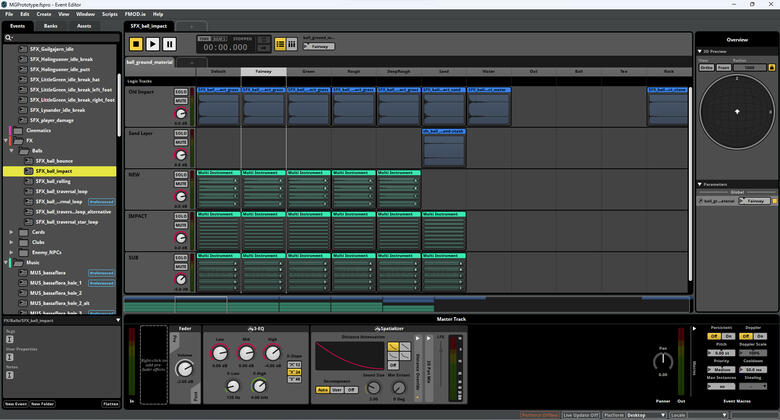

I joined Sucker Punch Productions in 2016 shortly after Ghost of Tsushima was greenlit for production. My main responsibilities at the time were focused on providing temp dialogue for the designers. Over time, my responsibilities grew and I provided implementation and sound design work for Ghost of Tsushima. I was also responsible for onboarding several of our contractors who joined us to help finish out the project. In my time at Sucker Punch, I worked on rigging buildings, phys tagging surface material types, paintmaps for ambience, ambience emitter placement, animation tagging, in game cutscene tagging, and more. Following release of Ghost of Tsushima, I remained on to assist in development of the multiplayer feature, Director's Cut and the Iki Island expansion.Engines: Wwise and Internal Proprietary
Bandit Walla
We needed to bring some life to some of the bandit towns and something we could use nearly universally within some of the Japanese towns as well. I took my jumping off point to design appropriate walla by reviewing some Japanese samurai films. We wanted the walla to have some cultural accuracy mixed with the style of film that Ghost of Tsushima is ultimately inspired by.Originally, we didn’t have any dialogue lines from peds that would help set the mood to create a good walla bed. I prototyped a sort of fake language breaking down the Japanese language phonetically and recorded some of my co-workers speaking the nonsense words. This ultimately didn’t make it into the game but allowed us to secure additional resources for our friends over at J-Studio to record some real Japanese walla to implement into the game.In addition to that, I recorded several variations of exertions you may hear such as burps, coughs, laughs, throat clears, and yawns. I put this into a quad setup with Right and Left front as well as Right and Left Back channels.

Putting it all together, We could use various parameters randomized within given constraints to make all these exerts and the background walla sound natural and give it space.
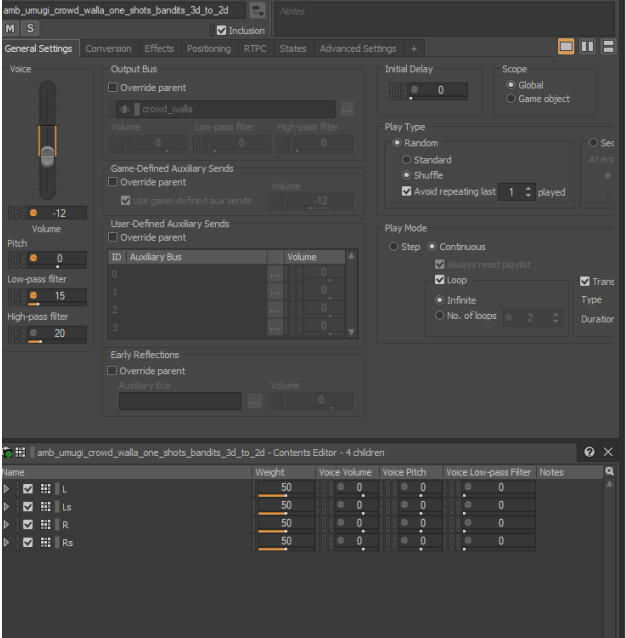
Next, I added a distance parameterto the RTPC, this allowed to collapse the event from a 3d quad loop to stereo as you close the distance to the source of the emitter.

Crying
We needed sounds of both male and female crying for ped animations. I gathered volunteers from our studio to record. Asking people to give reliable performances for crying is a difficult task, but I had some fantastic volunteers. Most importantly, I wanted them to have fun despite potentially actually crying which some used this moment to get out some serious sobs. I set up our recording booth with a comfortable chair, or they could opt to just sit on the floor. I had two mics set up to capture, a shotgun mic and a backup mic that was suspended overhead.I gave them about 20 minutes to just let it all out…After the session, I provided water, hot tea if they wanted, and some chocolate. I wanted to make sure that any real tears or emotional connection my co-workers experienced was countered by some good aftercare of endorphins so they could return to work feeling good rather than feeling drained. Hugs were also offered with full consent from myself and co-workers – pre negotiated of course. My coworker’s comfort was important to me as I felt this was a unique ask from them.So, taking that material, I broke down sections into Long Sobs, medium sobs, and short sobs. We also got sniffles recorded. The end result gave us a lot of material to cover animations in which peds are crying convincingly with some good variation and details to sell the sorrow and trauma of civilians in war.
Screams
This was one of my first tasks to record for Ghost of Tsushima. We needed some convincing terrifying screams. This was a challenge and to be honest I made a lot of mistakes to include how I placed the microphones and the record volume. Editing it was painful as the mistakes I made really caused a lot of my source to be unusable. I was able to salvage a lot of the material using iZotope RX4 to adjust levels and remove some of the distortion that got recorded. Despite the headache and having to learn from my mistakes, the material I was able to salvage worked well when mixed into the first mission.
Rivers and Waterfalls
Our technical artists assisted us in placing splines on the river to have emitters for water sounds placed a certain distance. However, in some cases, I needed to hand place additional emitters along the rivers to account for water flow and to give some variation to the rapids. All the waterfall emitters were hand placed by me. The challenge here was to find a good balance and to have a very natural sounding flow of water that accurately reflected the visuals.
Ped Animations
Just some examples of ped animations I implemented. Much of the process, we used a lot of temp assets to get an approximation – in some cases such as the sweeping and washing, we were able to take from other sounds being used in the game already and tweak them in Wwise to work for new content. This allowed us to get the animations set so any material we needed to get a higher quality on – such as the anvil hits, or the broom sweeping, we only needed to have the final asset dropped in as a content swap.
Building & Prop Rigging
There are multiple elements involved to rig up a building in Ghost of Tsushima to account for an immersive change in how we hear sounds both internal to the building as well as external. The final result was a collaboration between myself, Brad Meyers, and Josh Lord.

My workflow consisted of the following:
1. All the assets used to create a building needed to have the appropriate surface material types selected. This accounted for footstep type sounds based on the material.
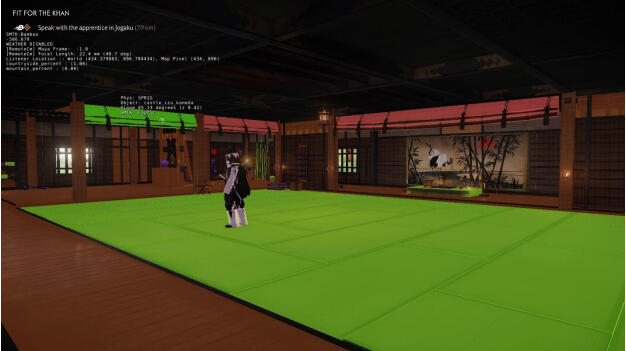
2. Impact Sound Overrides – in some cases, projectiles during combat could impact phys on the assets used to create buildings and props. There were defaults set, but depending on the asset size and condition, we could override which impact sound would play to get more detail and variation.

3. Many of the buildings were like legos, in which they could be combined with moderations based on how the design and environmentslayout team choose to place them. This meant mods could be toggled off or on depending on the choices made. This meant we needed to account for an awning requiring an overhang volume, but only when that mod was enabled. To begin the process of rigging, I would disable all the mods, so only the base asset would be visible to me. Then address each sound requirement per mod for the building.

4. Volumes: Open structures, doorways to the external environment received a volume with an overhang value. As you go further into a building and away from windows, we had additional levels of filtering such as inttoext, and interior. Windows to the outside received an overhang volume so the player can hear more weather and ambience as they walk by a window or an open door.Additional volumes could be added as needed to allow for sweeteners. These included creaky footsteps of two intensities. We also had volumes which included sound states for different surfaces that helped define the density of the surface you may traverse over. So our wood porches could sound just slightly different from our wooden roofs.Reverb could also be set in each volume to give the room space and to differentiate it from the external environment.Volumes were layered and given a priority value so the engine knew which volume took priority over another.

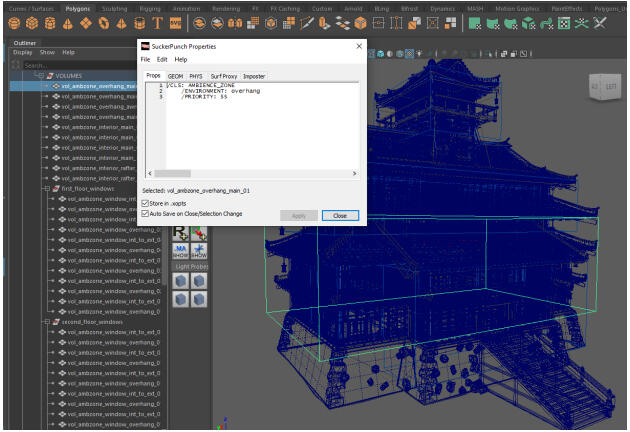
5. Emitters: Initially, we were hand placing rain emitters on the roof tops. We worked with engineering to automate that process through our ambience system. Rain emitters hand placed were done sparingly. Working with our Senior Sound Designer Josh Lord, we came up with the idea to use a blend of rain sounds for both external and internal,so the rain changes based on which volume the listener is in.Building Creaks helped give the buildings some character, we placed these in the rafters or around joists so as the wind blows through, the creaks would make the building responsive. We had several types of creaks depending on the state of the building – the more destroyed, the more creaking there may be.Windows with slats get emitters for wind blowing through the slats. Shoji Screen Windows get emitters for rattling wood and paper in the wind.

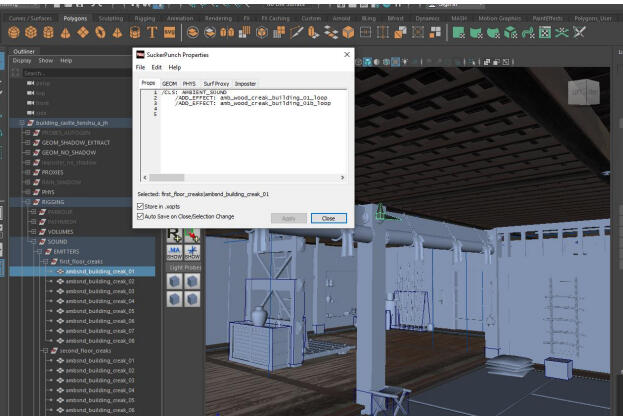
6. Parkour – many of the ledges, barstands, rails etc needed to be defined for surface material type so feet and hands would play the appropriate impact sound.
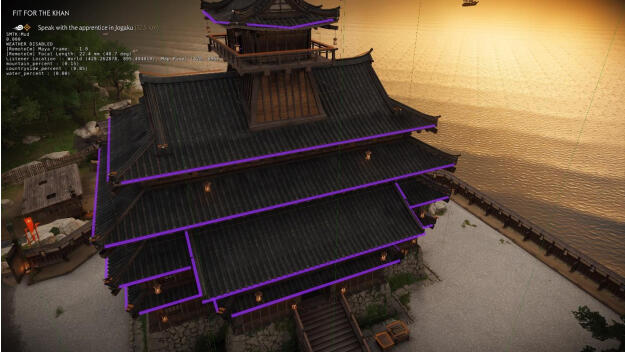
Wwise Tour
I had the pleasure of speaking about the Audio for Ghost of Tsushima at the Wwise Tour Online 2020
I joined Carbine as a QA Tester after my time as a Game Master at Blizzard. I was embedded into the Audio Team which allowed me to really start understanding how Game Audio works. I transitioned into the role of Audio Integration but quickly made my mark working with the Cinematics, Narrative, and Localization teams. Wildstar was an open world MMORPG. It was a sci-fi western full of unique worlds and incredible creatures. It was a joy to work on and I learned so much from the experience there.Engines: Wwise and Internal Proprietary
Wildstar Demo Reels
Voiceover Processing Demo Reel
Sound Design Demo Reel